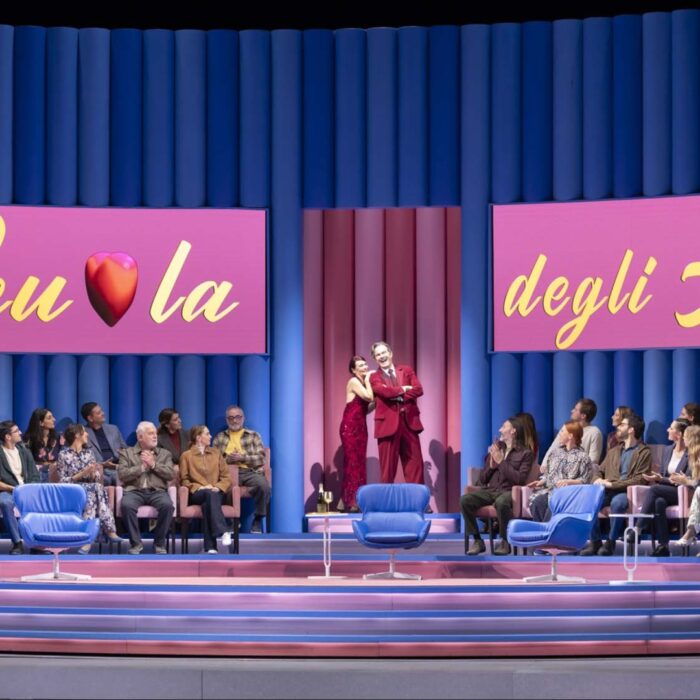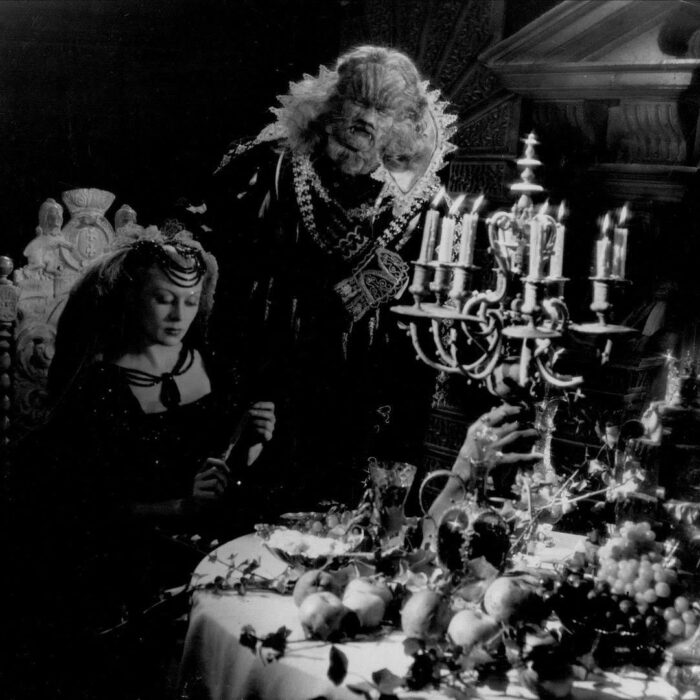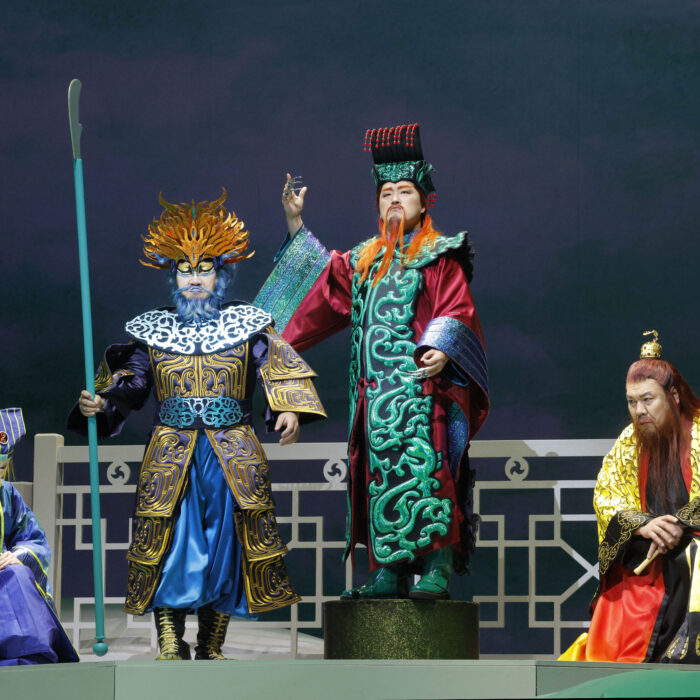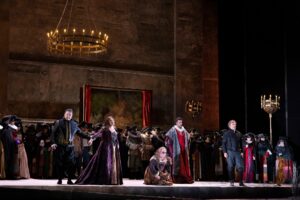
Teatro San Carlo 2023-24 Review: La Gioconda
Anna Netrebko & Ludovic Tézier Lead a Solid Performance of Ponchielli’s Rarely Performed Work
By Francisco SalazarEditor’s note: The initial review is for the performance on April 10, 2024 and was written by Francisco Salazar. The addendum is for the performance on April 13, 2024 and was written by David Salazar, who attended both performances.
It’s been 47 years since Ponchielli’s “La Gioconda” has been shown at the Teatro San Carlo.
Considered one of the most difficult works in the repertoire, it requires all six voice types and is rarely performed for this reason. For the new 2024 production, the Naples theater brought an all-star cast featuring three of the biggest opera stars in the world and three rising stars.
The result was an evening that had some mixed results but ultimately satisfied in many ways.
An Old Soul But Refreshing
For the new production, which is set to arrive at the Gran Teatre del Liceu in a future season, the Teatro San Carlo brought on French director Romain Gilbert. The production is set against the backdrop of a 17th century Venetian wall that transforms from a palace to a dock to a burned-down dock and a town square. It’s austere in its color but economical and fluid in its conception as the first and second act seamlessly move from scene to scene. The chorus is well-placed throughout and there are ballet dancers in the first act that showcase some spectacular movements including one dancer lifting two others, as well as dancers doing handstands on cartons, all while moving in a synchronized choreography. There are also some interesting special effects like the boat burning at the end of Act two.
The Act three Dance of the Hours, choreographed by Vincent Chaillet, essentially tells the story of Laura who is trapped and rescued by her lover from her tyrannical husband. It was well-danced by Cittoria Bruno and Salvatore Manzo. They moved about with smoothness and elegance as they danced their pas-de-deux. The only letdown came at the end as the allegro music saw an overcrowded stage of choral dancers moving about as if they were restricted by the lack of room. It also felt anticlimactic for a ballet that ends with such energetic music.
The costume designs by Christian Lacroix were also spectacular as they provided some elegance and color to the sets. In all, the production was refreshing as it was not trying to redefine the opera or lecture the viewer. It was simply letting the music and its singers do what they do best.
That said, I wish Gilbert would have had more time to work with his cast as half of them were coming from Salzburg and were in Naples for only one week. There was some tentativeness in some of the blocking and some of the character dynamics between Gioconda and La Cieca and Barnaba could have been stronger.
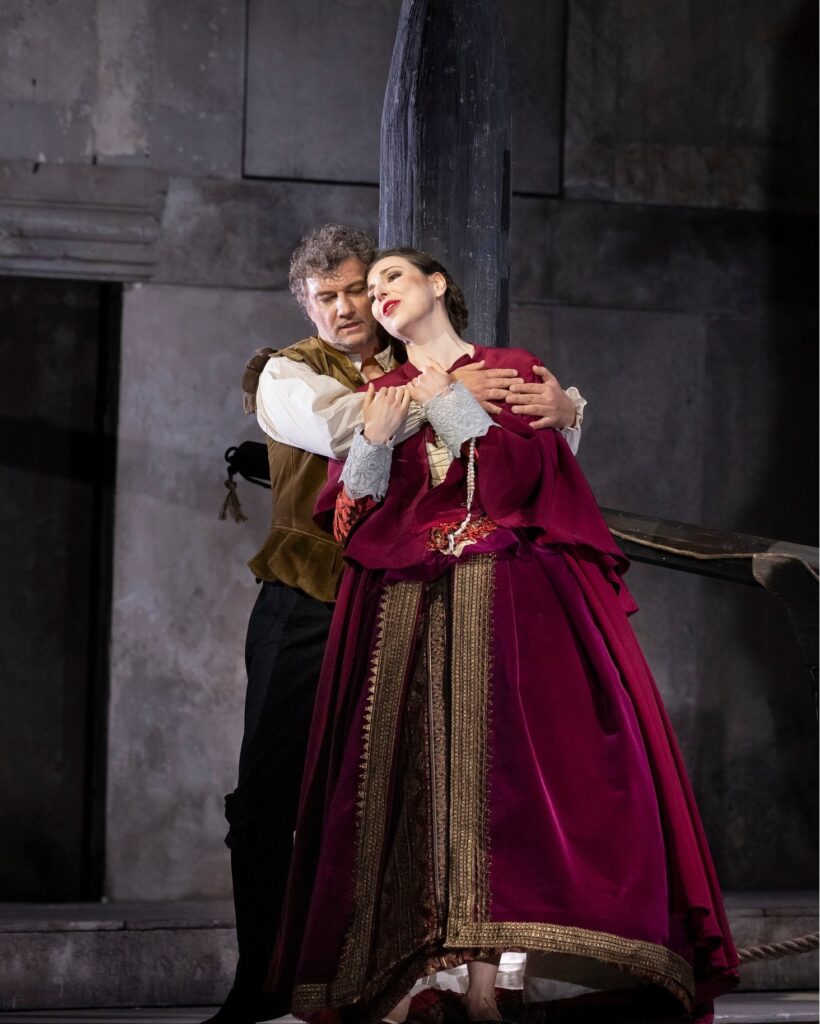
Unsteadiness But Intense
One of the evening’s drawers was undoubted Jonas Kaufmann. Having come from Salzburg where he made his stage role debut, the tenor’s voice sounded dried out and his legato lines had some arid quality. His high notes, while potent and heroic, were often cautious in execution. Many times the German tenor rose up to the high notes, only to move on from them as soon as possible, creating a general unease every time he would approach a high note. These issues were first apparent in his Act one duet with Barnaba, “Enzo Grimaldo, Principe di Santafior, che pensi?” where Kaufmann’s legato phrases were hard-edged and not flowing the way he has been known for. There were even some skips in his voice as he was ascending into his upper range. Right before “Cielo e Mar,” Kaufmann seemed to clear his throat, but throughout the famed aria, he struggled to get through the legato lines and his signature piannissi were arid and harsh. His climatic High B Flat on “Vieni” was cut short and on his final note, he tried to start forte and go piano all while lying down. It didn’t work and he immediately aborted the piano and crescendoed as fast he could to end the high note as soon as possible. But one has to give credit to Kaufmann, as he is one of the few tenors today who can phrase a line with delicacy and clarity and tries to give different colors with his voice. Even though it was clear he was struggling, he did his utmost to not compromise on his artistic vision for the aria.
In the subsequent duet with Laura, Kaufmann had some smoother moments and his legato phrases evened out. He sang with a piano line that matched gorgeously with Eve-Maud Hubeaux’s lyrical color and also emphasized the purity in the love between Enzo and Laura. It was one of the highlights on his evening.
The opera has two duets between Enzo and Gioconda, both which never have a truly defined structure. The first in Act two saw Kaufmann release all the might of his voice with intensity. He did have a mishap in the phrase “L’idol mio sapro strappar” where he reached a high note that turned raspy and was cut quickly (an audience member audibly gasped at this moment). But then he recovered during the “Tu sei tradito” concerto emphasizing Enzo’s suffering for Laura in the phrases “È un insulto.” His second duet in Act four saw Kaufmann perform with commitment and vigor. The anger in his character came to a climax in his “O furibonda iena che frughi il cimitero!” as the tenor balanced the highs and lows with flexibility.
In the role of Laura, Eve-Maud Hubeaux was also coming from the production in Salzburg, filling in last minute for an indisposed Anita Rachvelishvili. The mezzo is on the rise on the international scene and one could see why. She has an elegant sound and is a wonderful actress. On this night, however, she had a rocky start.
The first act saw her blend into the ensemble beautifully with her entrances showcasing her lovely, lyric voice at the height of its powers. But in Act two, where Laura has two duets and an aria, Hubeaux ran into some issues. As noted, the duet with Kaufmann, “Laggiu, nelle nebbie remote” saw the two sing with exquisite legato lines and lyrical precision. There dynamics melded together to create a sweet moment. Following the duet, as she sang her aria, “Stella del marinar,” her voice had an unsteady quality, especially in the opening lines as she managed through the syncopated rhythms and the lower notes. The “Scenda per questa fervida orazione” legato line was also marked by an unsteady vibrato. In the harrowing duet between Gioconda and Laura, Hubeaux gave it her all in matching Anna Netrebko’s intensity; she was particularly effective during the recitatives. Her opening “L’Amor come il fulgor creato!” was sung with an expressive tone but as she had to repeat the line, the mezzo seemed to struggle with the tempo. In the final coda, Hubeaux and Netrebko’s voices didn’t completely blend and the final note had some pitch issues.
That said, Act three was a tour-de-force for Hubeaux. Her duet with Alexander Köpeczi’s Alivse was exciting and raw. Hubeaux dug into her lower notes with such power and grit that one could sense the suffering but also her defiance in the character. Her “Morir! E Troppo orribile” was similarly riveting as she sang with a lyrical line that was steady but forceful as she employed accents on certain words. In the Act three, scene three exchange between Gioconda and Laura, Hubeaux gave into her acting powers, expressing the horror and fear as she drank the potion. In the Act four trio, Hubeaux had an angelic quality in her voice that favored the lighter aspects of her mezzo.
Rewarding Discoveries
In a cast of renowned artists, the Teatro San Carlo brought two rising stars who will surely be singers to look out for.
In the role of Alvise, Romanian bass Alexander Köpeczi had a striking and imposing presence. The role has an entrance in Act one, but his big scenes don’t come until Act three, and this is where he demonstrated his force. His opening recitative “Si, Morir ella de” was filled with anger and a booming bass. But that quickly turned to a demonic quality in “Là turbine e farnetichi,” as he sang with weighty low notes and accented staccato lines. His legato was stylish but also flexible, showcasing a wonderful bel canto line. In the ensuing duet with Hubeaux’s Laura, he dominated with his striking power and robust sound that matched well with the mezzo’s intense entrances.
In the role of La Cieca, Ukrainian contralto Kseniia Nikolaieva was superb. She brought an earthy and dark tone to the role showcasing the brooding quality of the character. Nikolaieva displayed a gorgeous vocal roundness in “Voce di Donna i d’angelo,” delivering smooth lines. It was one of the most moving moments of the evening as the voice rang with authority and nostalgia into the auditorium. Her opening song in the third scene of the opera “Tu canti agli uomini” was also quite beautiful and on the repeat, when she sang with Netrebko, the two voices gorgeously blended, the soprano’s slightly sweeter timbre contrasting with Nikolaieva’s darker tone. The final phrases of the first act were also splendidly sung between the two. Both voices rang nicely and showcased a spectacular comradery.
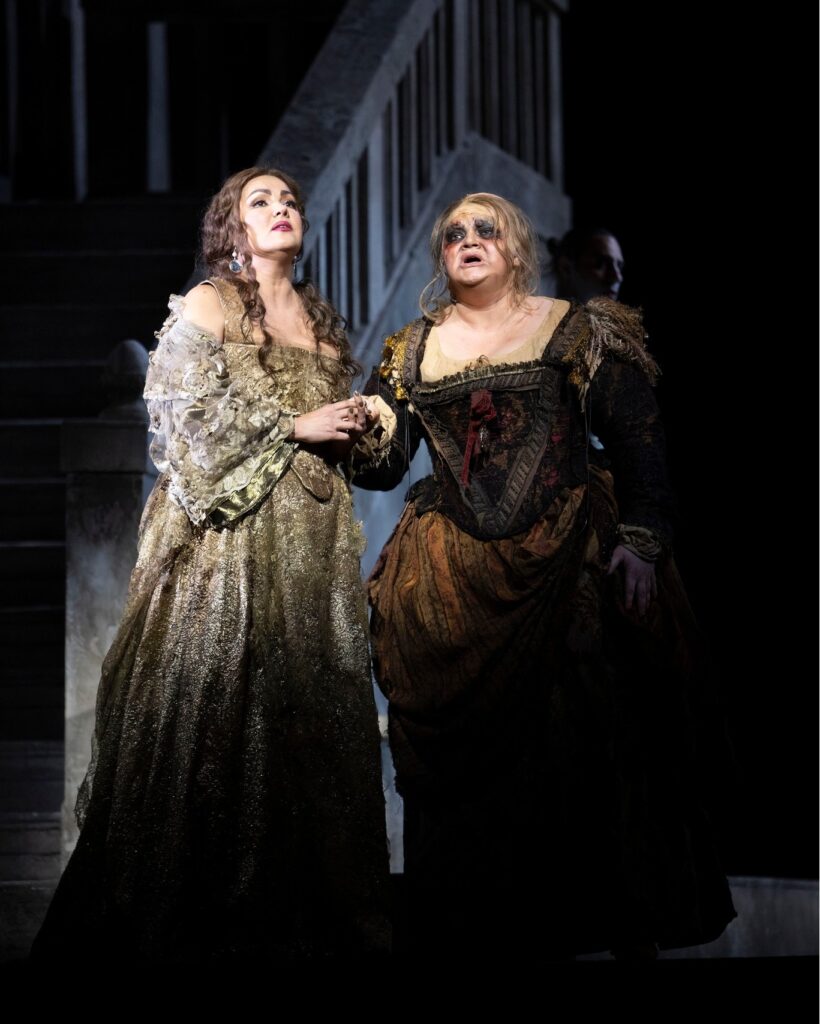
The Forces
In the title role, Anna Netrebko was singing her second production of Ponchielli’s opera after Salzburg. On this evening, the soprano was ill with a virus and admitted on social media that she had lost her voice right before the complex fourth act but decided to sing regardless. And while there were certainly pitch issues, especially in her upper register in the first and last act as well as some noticeable difficulty floating a few notes, there is no doubt that Netrebko was committed to each scene, bringing her customary intensity and digging into her increasingly weighty chest voice.
Netrebko began the performance with a lighter sound in the aforementioned song duet with La Cieca, singing with a round middle voice. In the final scene of Act one, when she discovers she has been betrayed by Enzo, the soprano’s voice took on a darker tone while retaining some lightness. That was best displayed by the “Dio! Soccombo…Il Fianco mio,” which showcased the gorgeous legato the soprano is well-known for. In Act two, Netrebko’s intensity grew as she released her full vocal powers during the duet with Laura. Her “Qual la folgor le vette” showcased a potent middle voice that easily moved into the lower register and quickly into the higher register to dispatch a flexible coloratura line. In the following duet with Enzo, Netrebko displayed a despondent physicality that was well-matched with raw lines. One of the show-stopping moments of the duet came in “questo lido e a lei funesto.” Here, her voice slowly grew from sweetness to forte, displaying all the contrasting emotions in Netrebko’s Gioconda. That eventually evolved into desperation as she fell to Kaufmann’s knees, begging him to return to her. Her “Tu sei tradito,” which was sung in its complete form, was dispatched with agility and intensity as she sang with clean chest notes while quickly moving into her higher register and singing over the immense ensemble.
But the highlight of the performance was without a doubt Act four during which Netrebko displayed tremendous emotion and dramatic commitment. Each phrase was given careful clarity, especially during her “Sucidio” which saw the soprano embracing her low notes with strength. The “perdei la madre” and “perdei l’amore” brought clear desperation to the character, while the final “dentro l’Avel” showcased a woman resigned to loss. The subsequent monologue”Ecco il velen” was full of great contrasts, giving the feel of a great mad scene. The opening saw the Russian sing with more resolve as she thought of killing Laura. But that slowly turned to torment on “Orror!” The climactic moment “pietà di me” was sung with great sorrow that turned to raw emotions in the duet with Enzo where Netrebko displayed gritty and forceful chest notes. In the trio, the voice returned to the light quality of the opera’s opening moments and here Netrebko attempted to float various phrases as she reached her high notes. It was clear she was reserving her voice, but it worked well with her colleagues as they all sang with a more restrained sound. In the final duet, the soprano continued with the lighter and lyrical quality to sing the demanding coloratura phrases. As she sang “Vo’ farmi piu gaia,” the soprano seductively twirled about the stage. The vocal line wasn’t always polished but it was a solid contrast to Ludovic Tézier’s harsher tone. Her final “Volesti il mio corpo” saw Netrebko dig deep into her gutsy lows as she stabbed herself. It was dramatically visceral.
In the role of Barnaba, Ludovic Tézier was the essence of evil. From the moment he walked on stage, he was in control of the scene, lurking and plotting each move calculated and manipulative; throughout, his voice boomed into the auditorium with an authoritarian bite. In the opening trio, you could see he relished singing the staccato line that contrasted well with Nikolaieva and Netrebko’s legato phrases. Similarly lecherous was his presence in the duo with Kaufmann’s Enzo, the baritone giving his lines ferocity. Tézier’s “O Monumento!” saw his voice grow with each phrase, taking on a demonic timbre. The aria got more violent as he reached the climax and at one point he choked Roberto Covatta’s Isepo, his voice like a dagger in its pointedness. It was a truly chilling dramatic and musical moment that exposed Tézier’s commitment to the villainy of this character.
In Act two the baritone’s interpretation of “Ah! pescatori, affonda l’escsa” was delivered with a conniving suavity. The coloratura roulades were solid and his patter lines were precise. His high notes were also bright and incredibly virtuosic as they rode over the orchestral and choral line. In Act three, he continued to be a scheming presence as he moved about the stage his gaze fixed on every character, slowly plotting his course. At the end of the act, Tézier loomed over Nikolaieva’s Cieca foreshadowing her fate. And in the final act, his hunger for Netrebko’s Gioconda was incredibly present as he sang “Ebrezza! Delirio!” in a triumphant spirit. Each line built with more brightness and desire. But as Tézier realized that Gioconda had stabbed herself, his voice returned to its demonic quality. His ” tua madre m’ha offeso! l’ho affogata” was sung with rage and vengeance. But there was a hollowness to the delivery that was quickly underscored by the terror he felt as he saw La Cieca’s ghost enter the stage in the final moments.
Solid Pacing
In the pit, Pinchas Steinberg led a solid performance moving the tempi forward and making sure the singers had space to sing the difficult music. There were moments though where he did go ahead of the singers, especially in “Suicido!” where he got off from Netrebko. He also noticeably slowed down the tempo during the soprano and mezzo duet, a tenativeness setting in that put the entire ensemble at risk. But overall, the music never felt like it dragged.
Props must also be given to the chorus, which was superb in the opening scene. The Act two sailor’s chorus was also interesting as it went from haunting at the opening to bright during Barnaba’s aria. The finale of Act three was also dramatic as they supported the principles with thunderous sound.
There are two performances left with this cast. It’s notable to mention that there were several cameras rolling on this performance. OperaWire was informed by one of the cameramen that the recording was a project for Unitel though there was no confirmation of any forthcoming release.
—————————————————————————————————————————————————————————————————
Editor’s Addendum (By David Salazar): This is undeniably a first in terms of our reviews, but it is a result of another rarity in this line of work, getting a chance to revisit a performance with the same cast during the same run. A few years ago, I wrote a piece on the limitations of reviewing one performance in a run and my ideal / not-so-ideal scenario of getting to see the full run and then getting an accurate exploration of the interpretation in writing. While there are a lot of ideas in that piece that I don’t necessarily endorse any longer, the one about not just reviewing a single performance in isolation is one I definitely do, especially in light of this run. And as such, I felt compelled to write this addendum to Francisco’s review, which expresses similar ideas to those I felt about the the first performance of “La Gioconda.”
This production was one of my most anticipated of the year; having a superstar cast is undoubtedly at the core of that. But the opening night performance was a massive letdown (maybe the most shocking one of my operatic life), mainly because it was impossible to immerse myself when I was worrying about some of the main singers being able to get through the music (not to mention that after hearing the boo-birds come to play in Milan and Rome for “Guillaume Tell” and “La Sonnambula” respectively, it was impossible not to fear for the singers; fortunately the audience in Napoli was far more polite in expressing its varying levels of interests for each singer on both nights without the need to resort to jeering or antagonizing artists). But performance number two was a completely different experience.
Jonas Kaufmann’s struggles in the opening evening, where it was evident that he was fighting something (as his constant throat clearing indicated) but also simply managing a voice that is not as flexible for these kinds of roles. As documented in the body of this review, his “Cielo e mar” was rough and the audience let the tenor know it with the most unenthusiastic lack of applause I have ever witnessed for a singer of his renown. Fast-forward to the second night and the experience was completely different. While there were still some blemishes in some of legato lines and a few flubbed notes in the middle range during the baritone-tenor duet, “Cielo e mar” was Kaufmann at his most supreme, the line fluid, the voice flexible, and the expression as impassioned as the tenor had intended that first night. You could feel the intensity of his desire for Laura, the architecture of the aria clear with each building line. Kaufmann was in control, and I was able to immerse myself in the experience without worrying about whether the tenor would falter on an upcoming high note or run out of breath and quickly abort an upcoming long line. The final B flat at the apex was delivered with his signature mezza di voce in all its pristine glory; the choice to do it standing up instead of laying down, like he did on the opening night, probably had a lot to do with it. It was vintage Kaufmann, the sound soared throughout the aria and the tenor continued to be in top form as the evening continued. Where the sound was arid and dry at the premiere, his signature piannissimi often feeling labored and uncomfortable, here those sweeter sounds flowed sublimely, especially during the duets with Hubeaux. These contrasted beautifully with his more aggressive vocal interactions with Netrebko’s imposing Gioconda, creating true dramatic tension that was often lacking the first time around. The audience was particularly enthused by his performance, greeting the end of “Cielo e mar” with a rousing ovation that was repeated at the close of the night.
Speaking of Anna Netrebko, she also had a vastly improved evening. While the soprano’s dramatic power was on full display in the opening night, her singing was not quite as tight and there was clear disparity in her lower and upper ranges; they often sounded like two different voices pieced together, one in far better form than the other. But on this evening, it all felt like one fluid instrument top to bottom. There were still some blemishes and some of the highs featured subtle intonation issues, but this was a performance of unwavering commitment that climaxed in a gut-wrenching interpretation of “Suicidio.” Netrebko’s strong vocal form, and Kaufmann’s, was also reflected in her body language. The first performance was solid, but there seemed to be a restraint in her interactions with her partners, especially the tenor. Perhaps this was the result of illness and being careful with her colleagues. But in this showcase, the movement was freer, the interactions more intense and potent. Kaufmann and Netrebko in particular looked more comfortable with one another, grabbing, holding, clutching, hugging, even roughing up one another during their big duets, matching each other line for line, aggression for aggression. Same with Netrebko and Tézier in the final scene, where the sexual nature of their interaction was far more present on the second night. This was the Russian diva at the peak of her powers and she created a believable portrait of Gioconda that made me forgive the libretto’s knee-jerk character shifts often present in pivotal dramatic moments (the frustrating amnesia regarding their feelings for one another — Gioconda shifting her attitude toward Laura on a dime after seeing the rosary or Enzo going from wanting to kill Gioconda to calling her “Benedetta” 10 seconds — are moments that could have used some musical development to be more readily believable); contrastingly, I couldn’t ignore the dramatic inconsistencies on the first night because nothing was coming together cleanly.
Then there was the orchestra and Pinchas Steinberg doing incredible work. He was great on the first night, but there was a freeness to his music-making on this second night that elevated the whole experience. The concerto at the close of Act three was a tremendously visceral experience not only because of how powerful and cleanly the ensemble came through, but also that it roared with such ardor and passion while also maintaining a clean balance with the soloists. I was thrilled to hear one audience member shout “Bravo orquesta” before Act four got to start and that the audience responded with rapturous applause. It was a much-deserved ovation on a tremendously successful night.
In sum, this second performance was everything I had expected the first night to be and wasn’t. As it happens, oftentimes, writers simply don’t get a chance to see the best performance of a run and the readers only end up hearing about the shortcomings of another evening. And sometimes the rough night is emblematic of the entire production. But in reality, we rarely ever get the full story. Even here, we have no idea what the third night of this cast, which will reportedly be recorded (there wasn’t a visible camera team at this one), will bring. Nonetheless, I am happy that I was able to get the opportunity to experience and share my thoughts on this second performance, which allowed me to move on from one of the most disappointing opera evenings of my life in favor of arguably the best performance I have seen this year, and one that will be hard to top.
